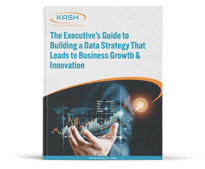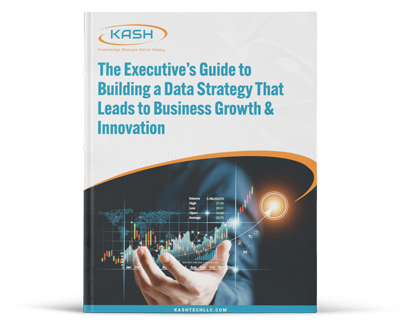Contents
Introduction
Are you frustrated with the lack of consistency in your data, conflicting or duplicated data, or the
lack of accurate business insights? If so, it’s time to change your current data strategy.
Your data strategy aims to create trustworthy, reliable data that can be shared across the organization and deliver actionable insights. Without trust in the data, organizations can become paralyzed in their decision-making process. Furthermore, the lack of accuracy in your data will
compromise the value of any machine learning or AI models and applications.
For most organizations, data still exists in multiple silos. Creating a single source of truth (SSOT) for all users is essential to building a data strategy for growth and innovation.
In this eBook, we will help businesses understand the roadmap to transform their reporting and data environment into one with a single truth source. Only then can data be trusted and deployed throughout the enterprise and to external channels to make better and more informed business decisions.
Download Your Personal
Copy of the eBook
Topics covered:
 Why developing a data strategy is critical to business growth
Why developing a data strategy is critical to business growth- Learn how to create a single source of truth
- How businesses currently approach data challenges
- A recommended approach to building a prosperous data strategy
Fill out the form to receive your personal copy of the eBook.
Download the eBook
What is Data Strategy?
Data strategy includes the tools, processes, and systems that define the collection, storage, governance, and analysis of data used for making business decisions. It provides a framework to ensure data is accurate and available for those that need it while complying with internal and external requirements.
Data strategy must be aligned with business strategy. This requires a clear set of
guidelines to define both short-term and long-term goals and ensure data practices
will help accomplish these goals. There also needs to be an understanding of who is
responsible for what aspects of implementing the data strategy.
For example, who will:
- Build the data pipeline and architecture?
- Collect and manage data?
- Cleanse and authenticate data in the pipeline?
- Analyze and interpret data?
- Have access to data?
The data architecture, tools, and processes must all support effective data management practices, including solid data governance, to ensure quality.

Challenges & Risks in Building a Data Strategy
86% of senior executives surveyed say eliminating data silos is critical to making data
useful in decision-making. Yet, the majority of companies struggle with data silos. They
don’t have a single source of truth for business information.
Critical data is unavailable to everyone and locked in isolation within applications and databases in support of multiple departments or divisions. In addition, this isolation leads to multiple versions of the same information across disparate systems, and both scenarios can lead to poor decision-making. For example, if data is formatted using spreadsheets and distributed to multiple users, each copy can be instantly out-of-date, and any changes made locally aren’t shared.
As a result, employees and stakeholders do not know which data is reliable and trustworthy.
Building a solid foundation for data that leads to business growth requires answers to questions
such as:
- How can I manage data quality across all of my business systems?
- How can we consolidate multiple data sources into one source of truth for our business?
- What factors are essential to ensure real-time data integration from various
business systems for reporting? - Is a data warehouse a single source of truth?
- How can I get a consensus on what is a single source of truth for my business information?
The questions are easy. The answers are often complex. As companies seek solutions, they find
it challenging to uncover where all of their data is located. A report by Barclays and the Institute
of Directors (IoD) found that 43% of organizations cannot identify the location of their critical
data.
While this may seem like a shocking number, it’s not an unusual occurrence. Organizations
adding to legacy systems often deploy additional resources to meet short-term tactical needs.
Yet, this can create even more data silos.
Data can get stale quickly when companies produce canned reports, Excel spreadsheets, or use
different data storage methodologies and analytics tools for different groups. In some cases,
other departments with access to only some data (due to data silos) may come to significantly
different conclusions. Not only can this create poor business decisions, but it also puts extra
burdens on end users to ensure they can find accurate, complete data.
There are significant risks to organizations continuing to do business as usual. They will
never achieve their goal of having a single source of truth, which means their critical business
information is at risk of being inaccurate and outdated.
Today, 90% of leading companies have invested in artificial intelligence (AI) and machine
learning (ML). Yet, the results cannot be trusted if the underlying data used to create these
models are inaccurate or inconsistent. Perhaps that’s why only 15% of organizations report that
they have deployed their AI solutions successfully.
Bad data never gets better with age, either. In fact, it compounds over time, making it more difficult to discern. One study shows the impact. If it costs $1 to verify a record when it’s created, the cost multiplies 10X to scrub and cleanse it later. You might also say that bad data infects good data, too. You can’t draw reliable conclusions when you are using poor-quality data to analyze correlations, trends, or anomalies.
It’s a significant issue.
Gartner estimates that poor data quality is responsible for an average loss of $15
million per year for enterprises.
Once employees and stakeholders no longer trust the data, it creates internal conflict. Some will
insist the data is good, while others will default to a gut instinct for decision-making. Often, users
try to fix things themselves as they don’t trust others to solve their data problems. This only
exacerbates the problem and adds to the cost of maintaining the status quo.
Instead of solving the problem, it adds to the proliferation of data silos and multiple tools to
address the conflicting data across the organization.

Without a comprehensive data strategy, companies can waste a lot of money and struggle to get the critical data they need to achieve business goals. At worst, it can lead to faulty decision-making, which can undermine performance, impacting key metrics like reputation, customer satisfaction, market share, and profitability.

Options for Solving Data Challenges
As organizations approach the process, there are several possible approaches to reigning in
data to build a single source of truth.

Companies can attack their data problems by setting up ongoing manual processes to address data accuracy. This requires a significant investment in human resources to manage and control the data. Not only is this a labor-intensive approach, but it can make the situation worse as users implement their own approaches to fixing data issues. Without addressing the challenges at the source, you simply cannot solve the problem.
Ovum Research concluded that addressing data quality issues on an ongoing basis can take between 10% and 30% of their total revenue.

Some vendors provide targeted solutions but may fail to address the holistic strategy. For example, solutions work with a specific application or platform while failing to make crucial data available to other applications.
The amount of data generated today is enormous and will only grow as more data sources and IoT (Internet of Things) devices are added. All of it has to be addressed and integrated into a comprehensive solution, yet organizations are struggling to keep up with the variety and volume of new data.

One option is to simply do nothing and maintain the status quo. A surprising number of organizations are doing exactly that. While they may work with their existing team members to mitigate data quality issues, many acknowledge the problem but then ignore it.
This creates a no-win situation. When critical issues surface, they can often lead to catastrophic results. Bad data about mortgage-backed securities and debt obligations led to a worldwide financial meltdown, causing large companies such as Lehman Brothers to declare bankruptcy. Data discrepancies between engineers at NASA and Lockheed Martin led to inaccurate calculations about orbital adjustments to the Mars Climate Orbiter, resulting in the loss of a $125 million asset.
Often, the discovery of data problems comes too late to undo the damage.
According to Gartner, nearly 60% of businesses do not measure the financial impact of poor-quality data. Without knowing the impact, they fail to see an urgency in addressing the problem.
Others believe that a single source of truth is a myth and the problem is too difficult to fix, so
they choose to ignore it.

A Better Approach to Building a Data Strategy
A successful data strategy requires a holistic approach. The overarching goal is to create a framework that allows the entire organization to leverage data to make better business decisions.
Earlier, we addressed the four key components of a traditional data strategy, but we believe
organizations must go further to solve data concerns. A comprehensive approach must include
the following:
- Data governance
- Master data management
- Data quality
- Data lineage
- Data security
- Data accessibility
- Data distribution
Data Governance
Before establishing a single source of trust, you must develop business rules. That’s because SSOT does not happen organically. It must be intentional. Because businesses handle data differently, the approach must be unique to each business, and everyone within the organization must commit to using the same data, business rules, and definitions.
Master Data Management
To understand the data sources and actual data available within your organization, you must start with analysis and cataloging. This can be challenging due to the significant number of disparate and often duplicated data. However, you can shortcut this process.
Data Mastering is the process of identifying categories of data (customer, product, services, vendors, etc.) across your organization in different sources, then synching those sources together to achieve a single controlling record for each of those categories. A consistent 360-degree view of patients’ healthcare is critical in managing the patient journey.
Data Quality
Data quality starts with your data governance. With a defined data governance structure, you can implement defined workflows and automate processes to ensure consistent data quality across all systems. This includes the process and the business rules for integrating and managing data across your sources and platforms.
A data warehouse is one component of an enterprise-wide data management strategy. At its core, a data warehouse is a data storage model that consolidates and aggregates data from multiple sources into a single data repository. However, it does not ensure the accuracy, consistency, or validity of all data sources across the enterprise.
You must have the tools and processes in place to monitor and manage data quality. It requires different tools and processes to ensure data quality.
There are several other methodologies for addressing the consolidation of multiple data
sources, including:
- Data marts
- Data lakes
- Operational data stores
- Data visualization
All require an understanding of the lineage of the data sources and the validity of the data they contain. Choosing the right solution for your business can be aided by engaging an unbiased third party to help build consensus on the definition of the single source of truth.
Data Lineage
Data lineage covers the data lifecycle as it flows through your infrastructure from ingest to consumption. You need a clearly defined and transparent path for all the transformations that data undergo along the way, including:
- How data was acquired
- How data was transformed
- Who changed the data
- Why data was changed
It is necessary to maintain data validity and identify any errors in the data process. Creating a data mapping framework gives you a complete view of data and ensures it is trustworthy. As data is often in flux — new data impacts existing data continuously — new data and new methods of gathering and storing data must be analyzed and tracked to reconcile datasets.
Data Security
To maintain quality, data must be secure. While those with a need must be able to access data, it must be protected against internal and external manipulation. Data strategies must include access management controls, data storage management, and data backup and recovery.
Confidentiality, integrity, and availability — known as the CIA triad — are essential for data-driven organizations, especially when it comes to securing data and diagnosing threats.
Data Accessibility
Without data accessibility for frontline employees, data often sits on the shelf or becomes strictly the domain of data scientists and IT teams. While you need to maintain strict controls for authenticating users to protect your data, you need to enable employees with the ability to access and analyze data to make informed decisions.
Eliminating data silos is critical, but you must also provide access. This doesn’t necessarily mean that every employee can access every data point. While some may need greater access levels, some employees may benefit more from real-time data visualizations with limited access to the underlying data.
Data Distribution
Your data strategy must communicate the data sources and how to access them to the team. Making data known and accessible and establishing a single source of truth are vital to creating and maintaining a data-driven decision-making culture.
This also requires a commitment from the top of the organization. Management’s recognition of the importance of data to the organization and their support of the investment in the people, processes, and technology needed to implement real-time data integration is crucial.

Download Your Personal
Copy of the eBook
Topics covered:
 Why developing a data strategy is critical to business growth
Why developing a data strategy is critical to business growth- Learn how to create a single source of truth
- How businesses currently approach data challenges
- A recommended approach to building a prosperous data strategy
Fill out the form to receive your personal copy of the eBook.
Download the eBook
Our Approach to Creating a Data Strategy Framework
Our solution is holistic and designed to fit each organization’s people, process, and technology and is not based on a particular technology or vendor. This vendor-agnostic approach helps design and implement the best solution rather than being limited by vendor solutions.
Because data quality is imperative for business today, you need new processes and technologies to address data quality issues. However, change can be disruptive. We work in parallel with the solutions you are already using, so it does not require you to stop implementing the new solution.
We analyze everything about your data and provide a pathway to create a single source of truth. Then, we help you monitor and measure it so you know areas that need to be addressed with input from across the organization.
Data is becoming increasingly important in making informed business decisions. At the same time, the amount of new data being collected is staggering. Companies failing to take action now to create a robust and scalable data strategy run serious risks. Some business leaders are skeptical that the problem can be solved quickly or cost-effectively. Others may be looking for a quick fix by adding a piece of technology. The reality is that it takes a comprehensive and holistic approach that encompasses people, processes, and technology to create the data strategy framework you need for growth and innovation. While this is more complex than just spinning up a server or migrating data to the cloud, it provides the infrastructure you need to build a data-driven organization for the future.
Take the Next Step
At KASH Tech, we focus on helping businesses transform from a state of informational chaos to an environment where critical business data and analytics are readily available — and trusted — across the enterprise.
We follow a four-step process to address clients’ needs using an adaptable methodology for best fit, accounting for the unique architecture and operations. This provides a logical, predictable pathway to create the long-term data strategy solution, using a predictable process from analysis and strategy through implementation.
To learn more, download KASH Tech’s Advanced Analytics Playbook: How to Unlock Breakthrough
Business Insights.
You can also request a data and analytics discovery call to discuss your organization and how we can help you build a data strategy for growth and innovation.

